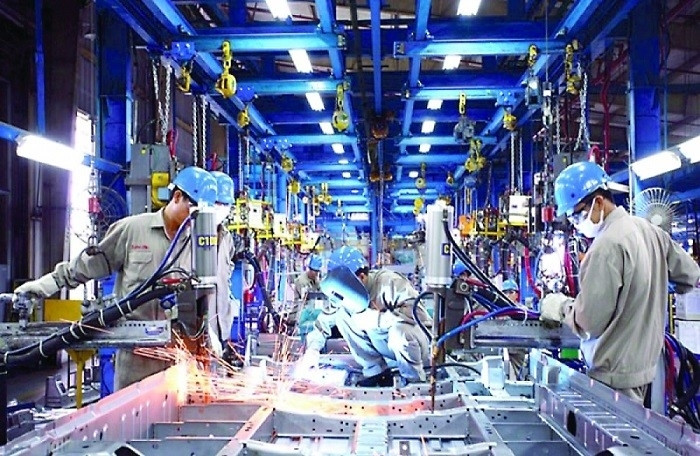
The resolution, covering 11 groups of key solutions with 142 specific tasks, aims to reach the objective of securing an economic growth rate of at least 6.5 per cent for 2023, with improvements in national economic competitiveness, and in the local investment and business climate in favour of investors and enterprises.
The government will continue implementation of tasks in a flexible and effective manner – to boost economic growth and complete institutions for the socialist-oriented market economy, thus facilitating economic recovery and development based on stabilising the macroeconomy and curbing inflation rate, as well as improving the economy’s resilience.
The government has requested ministries, municipal and provincial people’s committees, and other governmental agencies to comprehensively and effectively enforce main tasks and solutions to enhance Vietnam’s business environment and national competitiveness in 2023.
The government ordered priority to be given to improving a number of indexes and indicators regarding construction permit issuance, asset registration, settlement of contract disputes, bankruptcy of enterprises, land administrative management quality, application of information technology, quality of vocational training, students’ skills, patent granting, fighting against corruption, online transactions, job opportunities in knowledge-intensive sectors, and a sustainable ecosystem.
“We pledged to create an open investment environment and complete the legal system for effective investment, in the spirit of harmonising interests and sharing risks between the state, people, and businesses,” PM Chinh stated.
More enabling environment
Many companies were expecting such moves from the government heading into a new year, after a turbulent 2022 for many. In February last year, Nguyen Van Hoat halted the operations of his garment factory in Hanoi’s Dong Anh district due to shortages of materials and a rise in input costs. The factory was opened in 2019 and is the fourth that Hoat had established in the northern region of Vietnam since 2015.
Then in May 2022, the third factory based in the northern province of Bac Giang faced the same predicament, leaving the first two factories operating in moderation in the nearby province of Bac Ninh. The four factories are managed by Hoang Mai Garment and Trading JSC established in 2015, where Hoat is the director.
In October, two factories resumed operations after some major contracts were landed with both local and foreign experts, boosting work for hundreds of staff. “We are happy that all of our four factories are in full operations now,” Hoat said.
Hoang Mai company’s case is among 16,300 businesses that resumed operations in Q4 in Vietnam. Hoat added that he expected the government’s new resolution set to be signed this week will be materialised via specific measures and programmes by ministries, agencies, and localities.
At last week’s online conference on Vietnam’s socioeconomic situation in 2022 and for 2023, PM Chinh stated that despite a drop in industrial production, the economy is expected to bounce back strongly in 2023.
“Confidence in enterprises and investors is rising. This is a crucial factor for economic growth and employment generation,” he said. “In 2022, the number of newly established enterprises kept rising, meaning our policies for enterprises and investors have become effective.”
In 2022, the number of newly established businesses reached 148,500 registered at $69.17 billion, using 981,300 new labourers. These are up 27.1 per cent in the number of enterprises, down 1.3 per cent in capital, and up 14.9 per cent in labourers.
“If the $137.94 billion worth of new capital of the 50,400 operational enterprises is taken into account, the total registered capital supplemented into the economy in 2022 was $207.1 billion, up 15.2 per cent as compared to 2021,” reported the General Statistics Office (GSO).
Under a GSO survey on manufacturing and processing enterprises in Q4, 31.5 per cent of respondents expect their performance in Q1 of 2023 to get better than in the previous quarter, and 37 per cent expect their business will become stable in Q1.
Restoring confidence
Meanwhile, with the economy estimated to have grown 8.02 per cent in 2022, the Vietnamese government has asked authorised agencies to take drastic actions to continue spurring on economic growth, with a focus on fuelling business confidence and industrial production.
The government has required that it is necessary to closely monitor developments in the global situation, and developments in fiscal and monetary policies of countries and regions which are Vietnam’s main trading and investment partners.
In addition, it is necessary to actively and flexibly manage monetary policy; stabilise exchange rates and interest rates; control prices and markets; and ensure the supply of goods and major balances of the economy.
There must be solutions to limit the hoarding of foreign currencies and transferring assets in VND into foreign currencies, and to balance supply and demand and stabilise prices of essential items, especially for the upcoming Lunar New Year break.
Though Vietnam’s index for industrial production (IIP) is estimated to have risen at a relatively high level of 7.8 per cent on-year in 2022, the on-year figures were not as impressive, according to the GSO.
“The IIP for Q4 has been attributed to a plummet in enterprises’ orders and a rise in input costs as well as shortages of materials,” said Nguyen Thi Huong, general director of the GSO. “Industrial production in Q4 slowed down, with an added value estimated to increase only 3.6 per cent on-year.”
The IIP has witnessed an on-year decline over the past three months. After reaching a peak of 15.6 per cent in August, it started to decrease to 13 per cent in September, 6.3 per cent in October, and 5.3 per cent in November before falling to only 0.2 per cent in December.
In 2022, the number of businesses with halted operations reached 73,800, up 34.3 per cent on-year. The number of those with halted operations and waiting for dissolution hit 50,800, up 5.5 per cent; while the number of those having completing dissolution procedures touched 18,600, up 11.2 per cent.
Source: VIR